This is the third in a series about two structural fire academy candidates, Brandon Penrose and David Robinson, park rangers from Grand Canyon National Park. Their stories have been blended together.
“My mind was on overload with trying to remember what went where, who went where, and where everyone was. But I figure the best way for everyone to learn is to go through and experience.”

Day 4 — Mayday Mayday
The physical exertion that the course requires of all of us has finally caught up to a majority of the class. There were a lot of droopy eyes and dragging heels during the morning lecture. The last few days, each of the fire crews has had to pull numerous lengths of charged and uncharged hose line, as well as carry tools and extra air tanks around the fireground to build up muscle memory. The course is so condensed that there really is no time for extended breaks.
Today was the first day we left the Glen Canyon training area. We headed up to the Page Fire Department's training grounds. It's an area with pink shipping containers stacked on top of each other, creating a multistory structure, and shipping containers on the ground creating a confusing house layout.
Today was a rotation through several stations. The first, a smoked-out room was simulated by a fog machine filling the building with “fake” smoke. Even having helmet lights and chest lights didn't make a difference. You couldn't see a thing until you were five inches from the fire, which really added a sense of pressure and uncertainty. Not being able to see, moving on the ground with all our gear on, and breathing from SCBA is the real deal. Trying to control your breathing so you don't run out of air in five minutes is so incredibly hard. I'm not sure if I can convey in words how difficult it was to do that.
The rapid intervention crew (RIC) was a fun station. Teams are sent in to rescue a downed firefighter. Completely “blacked out,” we have to follow a hose-line to a mayday and PASS device activation (simulating a firefighter down) . Okay, so we followed the hose, found our partner, but now what? How are we going to get this guy out of the building? Not being able to see makes things a bit harder. We can wrap him up so we can drag him with webbing, carry him, or drag him by his SCBA. All these are viable options. But in the end, we need to get that person out and we have to do whatever is necessary to make that happen.
The next station was knot tying. This is pretty self-explanatory--we tied knots. Some knots are better than others for hauling equipment up. Clove hitch, half hitch, bowline, and overhand are standard knots used. We practiced tying knots on equipment and raising it to a second story.
The last station was a mayday drill. The mayday station tests your ability to remain calm and reflect on what you can remember from training. Envision yourself in a burning building. You have been crawling on your hands and knees on the hose line and you have an emergency. What do you do? You must be able to remain calm, control your breathing, and reflect on the situation that you are in. Being able to get to the radio and say “mayday, mayday, mayday” is the most crucial part of what you can do. But remember to say who, what, where, and then activate your PASS device. This was the most challenging station of the day.

Day 5 - Crash!!!
This morning was all about dealing with motor vehicle accidents and vehicle extrication, a very common occurrence in the national parks. We spent the first half of the day cutting up vehicles to extricate trapped patients. In my experience with the NPS, serious motor vehicle accidents happen often, and some of them require extrication skills that we are learning right now.
The instructors, with almost an unlimited supply of knowledge and information, had us cutting posts that hold up the roof of the car, punching out windows, rolling the dashboard forward, and cutting open the hood of the car to access the engine compartment using hand tools like sledgehammers and a halligan as well as with hydraulic tools. Believe me, even absent of a medical patient and the clamor of a billion other things going on, just the sound of the hydraulic generator and the power of the tools in your hands is enough to get your adrenaline going.
The second half of the day consisted of training evolutions involving deployment of hose lines to mount an effective fire attack. These drills were incredibly repetitive, but useful to build the team skills to effectively fight fire in the national parks. While the training was useful, it was above all tiring for me and anybody else that participated on the fireground.
The normal PPE for this type of training involves a heavy triple-layered coat, heavy Nomex trousers, a Nomex hood, thick gloves, a helmet, and an entire respiratory system weighing over twenty-five pounds. In addition to this, the sun was beating down and we were performing heavy physical activity. The positive side to all of the PPE is that our chance of getting burned is highly reduced, but on the negative side, none of the moisture that your body produces can get out. This lack of evaporation leads to an incredibly wet and hot day of training.
I was not ready for how complicated today would be. It's day five and although I have learned so much, I am still trying to grasp all the tasks at hand. Today was a problem-solving type of day. We would attack a fire in a simulated two-story building. One engine company would be on the bottom floor, one engine company would be on the top floor. Ready-GO! My mind was on overload with trying to remember what went where, who went where, and where everyone was. But I figure the best way for everyone to learn is to go through and experience, even if it is the hard way.
Part of a series of articles titled Structural Firefighting Academy.
Previous: Learning the Basics, Part 2
Last updated: December 2, 2016
